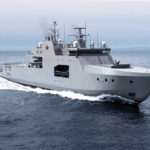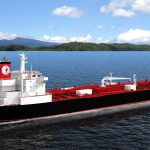HANSA takes a look at some large scale commercial and naval shipbuilding projects in the USA and Canada. Among interesting newbuilds, even a German-built container vessel is involved in a interesting conversion program
When it comes to shipbuilding, eyes in Europe are usually on the big competitors in Asia. News from across the[ds_preview] Atlantic are relatively rare. But it is worth taking a closer look. There not only a lot of large scale projects going on. While European shipyards can only outcompete the Asians in high-tech sectors such as cruise, offshore and innovative technologies, also US shipbuilders venture into the future of shipping, e.g. gas-powered ships – and quite successfully so.
General Dynamics NASSCO is responsible for one of the most notable deliveries of commercial vessels in 2015, the 3,100TEU vessels »Isla Bella« and »Perla del Caribe« for TOTE. These are the world’s first gas-fuelled containership newbuildings. NASSCO has six commercial ships in its backlog with deliveries scheduled between 2016 and 2017. This includes another four medium-range Jones Act tankers for Kinder Morgan’s American Petroleum Tankers (APT) that will be completed between early 2016 and mid-2017. The first of the five-ships series, »Lone Star State«, was delivered in December 2015.
The 50,000 dwt ECO-class vessels will have a capacity of 330,000 bbl and were designed by DSEC, a subsidiary of Daewoo Shipbuilding & Marine Engineering (DSME). The design incorporates improved fuel efficiency concepts through several features, including a slow-speed main engine and an optimized hull form. The tankers feature a ballast water management system and will enable installation of an LNG fuel-gas system in the future. According to NASSCO these tankers are 33% more fuel efficient than the previous five State-Class tankers built for APT between 2007 and 2010.
Philly Shipyard, formerly known as Aker Philadelphia Shipyard, is building another two 50,000 dwt tankers for Crowley, scheduled for 2016. Two vessels of the same type have already entered service. The company’s backlog until 2018 also includes four tankers for Kinder Morgan’s APT. The newbuildings are based on a Hyundai Mipo Dockyards design featuring fuel efficiency features and flexible cargo capability. The propulsion system can be converted to the use of natural gas in the future. When completed, each of the 183m tankers will have a carrying capacity of 14.5 mill. gal. to transport crude oil or refined products.
For an aggregate price of 418mill. $ Philly Shipyard will also build two 3,600TEU containerships for Matson Navigation. The 259m Aloha-class vessels will be the largest Jones Act containerships ever constructed and are designed to operate at speeds in excess of 23kn on the Hawaii–US Mainland services, the shipyard states. The ships will be equipped with dual fuel engines that have LNG capability and will incorporate a number of »green ship technology« features such as a fuel efficient hull design, double hull fuel tanks and fresh water ballast systems. Steel cutting started in October 2015, delivery is expected in the third and fourth quarters of 2018.
Also for Crowley, VT Halter marine is currently constructing two gas powered ConRo ships, »El Coqui« and »Taíno«. The 26,500 dwt vessels will have a cargo capacity of 2,400TEU and space for 400 vehicles and will be deployed on the Costa Rica trade (read more on page 53).
Gulf Coast Shipyard Group, which together with Trinity Yachts has been acquired by shipping company Harvey Gulf in June 2015, is building another four dual-fuel PSVs for Harvey Gulf. The first of the six LNG-powered vessels, »Harvey Energy« and »Harvey Power« are already in service, waiting to be accompanied by »Harvey America«, »Harvey Freedom«, »Harvey Liberty« and »Harvey Patriot«.
A little smaller in size are two Support Vessels being built for Harvey Gulf at Eastern Shipbuilding. The Robert Allan-designed 61m long »Harvey Stone« will be handed over later this year. Eastern is also building a sister ship and two Vard-designed Support Vessels for Harvey Gulf.
Vigor is building the third of three ferries for Washington State Ferries (WSF), the USA’s largest ferry system. In June 2014 the »Tokitae« was delivered, »Samish« in April 2015. »Chimacum« is scheduled for delivery in early 2017. The ferries have a capacity for 144 cars and 1,500 passengers at a length of 110.4m, a beam of 25.4m and 7.5m draft. In late 2018, Vigor will deliver two ferries for the Alaska Marine Highway System. The vessels built in Alaska will have a length of 85m and will carry 300 passengers and 53 cars.
Naval contracts
Orders from the US Naval Forces are vital for securing American shipbuilding know-how. Besides refit and long-term maintenance contracts, the large shipyards are almost constantly utilized for newbuilds.
Huntington Ingalls Industries’ Ingalls Shipbuilding is currently building four Arleigh Burke class destroyers (DDG 113, 114, 117 and 119 ). DDG 113 scheduled to be delivered in 2016. To date, Ingalls has delivered 28 DDG 51 destroyers to the US Navy. The company has also received a long lead materials funding contract for the US Coast Guard’s seventh Legend class National Security Cutter (NSC).
GD Electric Boat and HII Newport News Shipbuilding are also constructing the nuclear-powered 29.8 MW Virginia-class submarines. The 13th boat of the series was delivered in December last year. The vessel type has a length of 115m, a beam of 10.4m and a displacement of 7,900t.
The world’s most expensive ship, aircraft carrier »Gerald R. Ford«, will be delivered in 2016, builder Newport News says. The new Ford-class will replace the Nimitz-class carriers. The use of completely new technology delayed the building process several times and led to increased costs of 13bn.$. The next vessel, »John F. Kennedy«, is expected to enter service in 2020.
After the US Navy has received its sixth 103m Expeditionary Fast Transport (EPF6) in January, Austal currently has another three vessels of the Spearhead-class aluminum twin-hull under construction. EPF7 is expected to be delivered soon. Start of construction of the tenth vessel is scheduled for late 2016 and two more ships have been funded by Congress.
Following the delivery of the first ship in the Expeditionary Mobile Base ESB-class, »Lewis B. Puller«, to the Navy, NASSCO started construction of a second vessel in October 2015. The 240m ship includes a 4,800m3 flight deck, fuel and equipment storage, mission planning spaces and accommodations for up to 250 personnel. In December 2015, Congress approved 635 mill. $ in funding for a third ESB.
Louisiana based Bollinger Shipyards is busy building the Coast Guard’s Sentinel-class Fast Response Cutters (FRC). In early 2015 USCG exercised the contract option for the 31st and 32nd ship of the 58 vessel program. The total value of the contract is said to be 1.48 bn. $. Bollinger so far has delivered 16 FRC, which are based on a Damen Shipyards design.
With commerce and traffic in the Arctic increasing, including petrochemical exploration and fisheries, the US Coast Guard is also in need of new heavy icebreaking capability. It is not decided yet where the two new vessels will be built. Critics say, the US shipyards do not have the expertise to build those vessels should look for capabilities or expertise outside the US. The Coast Guard announced a meeting in March for companies interested in building the vessels, that could cost up to 1 bn. $ each.
Canada
The Canadian government’s National Shipbuilding Procurement Strategy (NSPS) is finally seeing steel being cut for the first vessel. The 36.6 bn. CAD program includes combat and non-combat vessels of the federal fleet, that will be built by Irving Shipbuilding in Halifax and Seaspan Shipyards in Vancouver. Seaspan is the non-combat partner and will build three Offshore Fisheries and Science Vessels, one Offshore Oceanographic Vessel, two Joint Support Ships, one Polar Icebreaker, five Medium Endurance Multi-Tasked Vessels and five Offshore Patrol Vessels.
Irving was chosen to be the builder of the combat vessels. The Canadian Navy needs to renew its fleet and will get – presumably over a long period of time – five Arctic Offshore Patrol Ships (AOPS) as well as up to 15 Surface Combatants. In January 2015 the contract for the construction of the AOPSs, total project cost was initially estimated at 3.1 bn. CAD for eight vessels. The number of ships was later reduced to five, while the budget was increased to 3.5 bn. CAD, with an option for a sixth vessel in case the budget will not be exceeded.
The Patrol vessels of the Harry DeWolf-class will have a length of 103m and a beam of 19m. Propulsion will consist of two 4.5 MW main engines and four 3.6 MW generators. The vessels will have the ability to navigate through 1m first-year ice and to sustain operation for up to four months.
For improved navigation capabilities the AOPS will be equipped with a bow thruster and Retractable Active Fin Stabilizers to reduce ship roll. Those devices will be retracted for operations in ice. A 20t crane will enable the vessel to load containers, underwater survey equipment or a landing craft. The flight deck will accommodate helicopters up to the size of the CH-148. In September 2015, construction of the first ship started. In 2018 is will be delivered to the Navy.
Before as part of the Shipbuilding Procurement Program new Joint Support Ships will replace the Protecteur-class, »Project Resolve« is intended to bridge the gap. The project focuses on the conversion of a containership into an Auxiliary Oiler Replenishment ship to replace »Protecteur« and »Preserver«. Davie shipyard already bought 1,702TEU vessel »Asterix«, built at German Nordic Yards as »Neermoor« in 2010 for 20mill. CAD (15mill. $). The conversion project will cost 270 mill. to 320mill. CAD.
The conversion-design was done by Canadian naval architect NavTech and the works will be carried out by AECON Pictou Shipyards, Nova Scotia, and Chantier Davie Canada, Quebec. The vessel will feature a cargo hold for containers, deck cranes, a hospital and a flight deck for helicopters up to Chinook-size.
The AOR will serve as a bridging solution until the two new Queenston-class Joint Support Ships will be ready. The vessels will be based on the German Navy Berlin-class design, and are expected to enter service in 2020. There is also an option for a third Queenston-class ship.
Felix Selzer



















